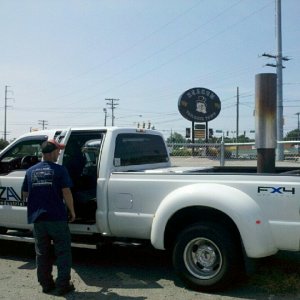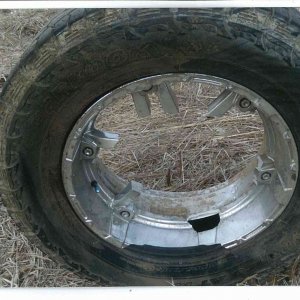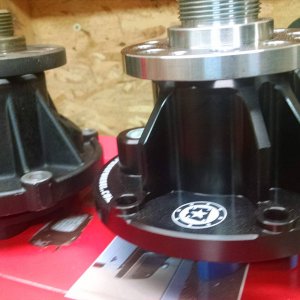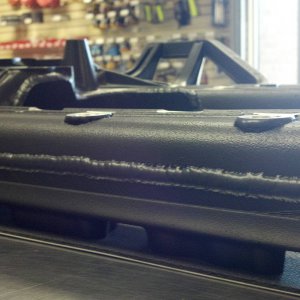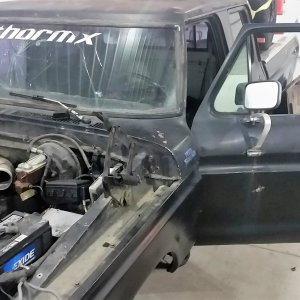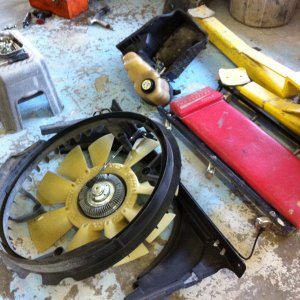Plenum
I don't see the argument here. Upgrading your plenum size isnt going to make more air go into the heads.
It could. If the volume of the plenum is only roughly that of a single cylinder's displacement, then each time one cylinder's intake valve opens there would be a sizable drop in the pressure of the manifold. When the intake valve closed again the pressure would spike up high. Depending on firing order and cylinder layout, certain cylinders would get air during a spike, while others got air during a lull in pressure, leading to reduced power through uneven contribution.
A larger plenum volume would dampen the pressure fluctuations and give more uniform distribution to each cylinder.
Your turbo pushes air. The air HAS to go somewhere. Unless the air reaches a restriction so great that it can overcome the force of exhaust gasses compressing the incoming air, then no air will stall until it gets to the head and then the valves. The only difference I see in the plenum designs (stock vs larger) is the pressure at which the air enters the head.
The turbo doesn't change the airflow. At 5psi there is exactly the same CFM moving through the intake and heads as at 500psi.
This is why higher flow rates for heads, intakes and valves apply equally to NA and forced induction engines. The concepts of runner length, shape size also hold the same effects. The only way to increase CFM flow is through these things. Turbocharging only increases the weight of each CFM, not how many pass through the engine every two revs.
The concepts behind plenum volume requirements for an NA engine hold just as true for forced induction engines. The forced induction engine is required to flow fewer CFM than the NA engine, due to higher density of each of those cubic feet, but the effects of intake charge velocity, timing and dampening fluctuations are all working just the same forced induction as NA. It's like you drive an NA car down to death valley, vs the top of Mt. Everest. At death valley you'd be forced induction in comparison. In neither case does the engine move more or less CFM, but because the air is much denser in death valley, it sure makes more power with those CFM.
Example: flow 300cfm through a 1" diameter tube. It will flow at X psi. Flow the same 300cfm air through 2" diameter tube and it will flow at X/2 psi. No less air flowed, only at a different pressure between two points.
Although a 2" diameter line is actually much more than twice the flowable area of a 1" line, I see what you're getting at, and yes, the same flow through a reduced restriction requires less pressure. Well, if your intake runners are ____ square inches in section, and the pressure in the manifold is fluctuating wildly because the plenum is insufficiently sized to handle the demands, then some cylinders will receive _____psi while others might receive much less. The ones receiving much less pressure will also fill less. And even as each single cylinder opens the plenum pressure will drop, so that even just by the end of each cylinder's intake stroke the pressure will be lower than average by a meaningful amount. In this case all cylinders have reduced filling.
The turbo has nothing to do with that.
That's not to say I don't like the Riffraff plenums (I assume there are others, just haven't looked), I just don't think flow has anything to do with it. Just like how changing your rear diff oil to synthetic will improve MPGs.. To me the pluses of these aftermarket products is looks, quality, and strength.
Sent from my iPhone
On Edit:
Going from the stock superduty intake plenum to the Van intake plenum that is MUCH smaller in volume, my boost gauge fluctuation quadrupled. From minor shaky movement to 5+ psi movement.
Now bare in mind, this is at the end of an 1/8th" signal line all the way up in the cab, on a gauge that is at least somewhat dampened itself. The fluctuations occurring right at the heads is probably insane.
The plenum needs to ideally be 2 or 3 times the displacement of a single cylinder. That will handle the fluctuations nicely, which I plan to do as soon as I rid my valley of a turbo.


